【公开课教案】外研版高一英语必修四unit4 reading 教案
- 格式:doc
- 大小:527.00 KB
- 文档页数:15
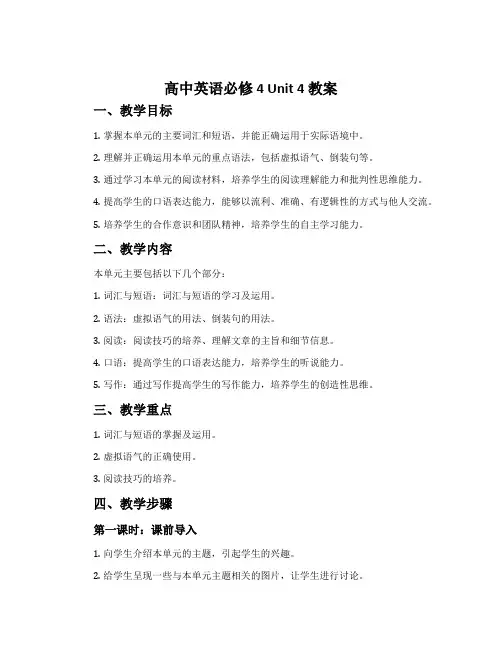
高中英语必修4 Unit 4 教案一、教学目标1.掌握本单元的主要词汇和短语,并能正确运用于实际语境中。
2.理解并正确运用本单元的重点语法,包括虚拟语气、倒装句等。
3.通过学习本单元的阅读材料,培养学生的阅读理解能力和批判性思维能力。
4.提高学生的口语表达能力,能够以流利、准确、有逻辑性的方式与他人交流。
5.培养学生的合作意识和团队精神,培养学生的自主学习能力。
二、教学内容本单元主要包括以下几个部分:1.词汇与短语:词汇与短语的学习及运用。
2.语法:虚拟语气的用法、倒装句的用法。
3.阅读:阅读技巧的培养、理解文章的主旨和细节信息。
4.口语:提高学生的口语表达能力,培养学生的听说能力。
5.写作:通过写作提高学生的写作能力,培养学生的创造性思维。
三、教学重点1.词汇与短语的掌握及运用。
2.虚拟语气的正确使用。
3.阅读技巧的培养。
四、教学步骤第一课时:课前导入1.向学生介绍本单元的主题,引起学生的兴趣。
2.给学生呈现一些与本单元主题相关的图片,让学生进行讨论。
3.向学生提出一个问题,引导他们思考本单元的学习目标。
第二课时:词汇与短语学习1.给学生呈现本单元的词汇和短语,帮助他们掌握词汇的拼写和词义。
2.进行词汇和短语的操练,包括填空、连线和造句等活动。
第三课时:语法学习1.介绍虚拟语气的基本概念和用法,帮助学生理解虚拟语气的意义和作用。
2.通过例句和练习,让学生掌握虚拟语气的具体用法。
第四课时:阅读技巧培养1.向学生介绍阅读技巧的重要性,引导他们了解如何提高阅读理解能力。
2.给学生呈现一篇有关本单元主题的阅读材料,让学生独立阅读并回答相关问题。
3.分析阅读材料的结构和语言特点,引导学生从不同角度理解文章的意义。
第五课时:口语表达能力培养1.给学生提供一些与本单元主题相关的情景,让学生进行角色扮演并进行对话练习。
2.引导学生用所学到的词汇和短语进行口语表达,改进他们的口语表达能力。
第六课时:写作能力培养1.向学生介绍本单元写作任务的要求和目标。
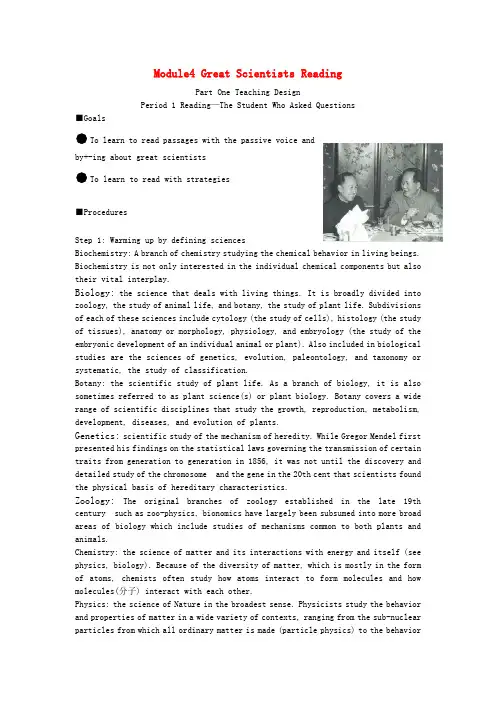
Module4 Great Scientists ReadingPart One Teaching DesignPeriod 1 Reading—The Student Who Asked Questions■Goals●To learn to read passages with the passive voice andby+-ing about great scientists●To learn to read with strategies■ProceduresStep 1: Warming up by defining sciencesBiochemistry: A branch of chemistry studying the chemical behavior in living beings. Biochemistry is not only interested in the individual chemical components but also their vital interplay.Biology: the science that deals with living things. It is broadly divided into zoology, the study of animal life, and botany, the study of plant life. Subdivisions of each of these sciences include cytology (the study of cells), histology (the study of tissues), anatomy or morphology, physiology, and embryology (the study of the embryonic development of an individual animal or plant). Also included in biological studies are the sciences of genetics, evolution, paleontology, and taxonomy or systematic, the study of classification.Botany: the scientific study of plant life. As a branch of biology, it is also sometimes referred to as plant science(s) or plant biology. Botany covers a wide range of scientific disciplines that study the growth, reproduction, metabolism, development, diseases, and evolution of plants.Genetics: scientific study of the mechanism of heredity. While Gregor Mendel first presented his findings on the statistical laws governing the transmission of certain traits from generation to generation in 1856, it was not until the discovery and detailed study of the chromosome and the gene in the 20th cent that scientists found the physical basis of hereditary characteristics.Zoology: The original branches of zoology established in the late 19th century such as zoo-physics, bionomics have largely been subsumed into more broad areas of biology which include studies of mechanisms common to both plants and animals.Chemistry: the science of matter and its interactions with energy and itself (see physics, biology). Because of the diversity of matter, which is mostly in the form of atoms, chemists often study how atoms interact to form molecules and how molecules(分子) interact with each other.Physics: the science of Nature in the broadest sense. Physicists study the behavior and properties of matter in a wide variety of contexts, ranging from the sub-nuclear particles from which all ordinary matter is made (particle physics) to the behaviorof the material Universe as a whole (cosmology宇宙论).Step 2: Before you readPlease go over the word list for this module, paying attention to the pronunciation of the word, the relationship between its pronunciation and its spelling.Step 3: While you read1. Type of writing and summaries of The Student Who Asked Questions2. A diagram of The Student Who Asked Questions3. Complete the article with one word in each blankThe Chinese scientist, Yuan Longping, is a _1_ figure in the rice-growing world. When he was educated in school he was given the _2_ , “the student who asks questions”. From an early age he was so interested in plants that he _3_agriculture in college. As a young teacher he began experimenting in crop breeding. First Yuan Longping _4_ with different types of rice. The results became known in China in 1966.Then he _5_ his search for a special type of rice plant. It had to be male. It had to be sterile. Finally, in 1970 a _6_sterile male rice plant was discovered. This was the breakthrough. As a _7 _of Yuan Longping’s discoveries Chinese rice production rose by 47.5 percent in the 1990’s. There were other _8_, too. 50 thousand square kilometers of rice fields were converted to growing _9_and other cash crops. Following this, Yuan Longping’s rice was exported to other _10_, such as Pakistan1. What does “staple” mean in “In a hungry world rice is a staple food and China is the world’s largest producer”?A. chief or prominent among the products exported or produced by a country or district; chiefly or largely dealt in or consumed.B. basic, chief, or principal: staple industries.C. principally used: staple subjects of conversation.D. important and outstanding2. He studied agriculture in college and as a young teacher he began experiments in _____.A. crop breedingB. feeding peopleC. sterile male riceD. with different types of rice3. He thought that the key to have more rice was by _____.A. experimenting with different types of riceB. asking questionsC. crossing different species of rice plantD. searching for a special type of rice plant4. Finally, in 1970 a _____ was discovered. This was the breakthrough.A. staple foodB. new plant which could give a higher yieldStep 4: After you readYou are going to read the text again and draw a diagram of it. You may use the diagram to retell the story in your own words.。
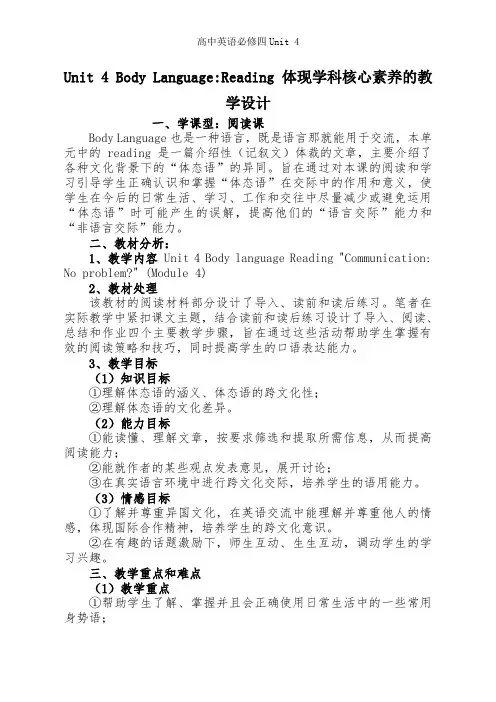
Unit 4 Body Language:Reading 体现学科核心素养的教学设计一、学课型:阅读课Body Language也是一种语言,既是语言那就能用于交流,本单元中的reading是一篇介绍性(记叙文)体裁的文章,主要介绍了各种文化背景下的“体态语”的异同。
旨在通过对本课的阅读和学习引导学生正确认识和掌握“体态语”在交际中的作用和意义,使学生在今后的日常生活、学习、工作和交往中尽量减少或避免运用“体态语”时可能产生的误解,提高他们的“语言交际”能力和“非语言交际”能力。
二、教材分析:1、教学内容 Unit 4 Body language Reading "Communication: No problem?" (Module 4)2、教材处理该教材的阅读材料部分设计了导入、读前和读后练习。
笔者在实际教学中紧扣课文主题,结合读前和读后练习设计了导入、阅读、总结和作业四个主要教学步骤,旨在通过这些活动帮助学生掌握有效的阅读策略和技巧,同时提高学生的口语表达能力。
3、教学目标(1)知识目标①理解体态语的涵义、体态语的跨文化性;②理解体态语的文化差异。
(2)能力目标①能读懂、理解文章,按要求筛选和提取所需信息,从而提高阅读能力;②能就作者的某些观点发表意见,展开讨论;③在真实语言环境中进行跨文化交际,培养学生的语用能力。
(3)情感目标①了解并尊重异国文化,在英语交流中能理解并尊重他人的情感,体现国际合作精神,培养学生的跨文化意识。
②在有趣的话题激励下,师生互动、生生互动,调动学生的学习兴趣。
三、教学重点和难点(1)教学重点①帮助学生了解、掌握并且会正确使用日常生活中的一些常用身势语;②把握篇章中心内容,获取文章关键信息。
(2)教学难点①培养学生的阅读策略和技巧。
②了解由于文化背景的差异而造成见面问候方式不同的现象。
四、教学设计(一)总体设计本节课是阅读课,教学重点是培养学生的阅读策略和技巧,同时引导学生用所学语言知识及写作技巧完成课后的书面表达练习。
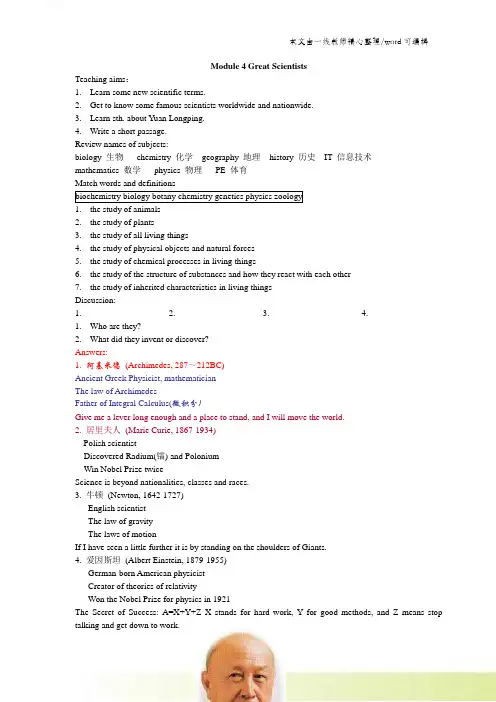
Module 4 Great ScientistsTeaching aims:1.Learn some new scientific terms.2.Get to know some famous scientists worldwide and nationwide.3.Learn sth. about Yuan Longping.4.Write a short passage.Review names of subjects:biology 生物chemistry 化学geography 地理history 历史IT 信息技术mathematics 数学physics 物理PE 体育Match words and definitionsbiochemistry biology botany chemistry genetics physics zoology1.the study of animals2.the study of plants3.the study of all living things4.the study of physical objects and natural forces5.the study of chemical processes in living things6.the study of the structure of substances and how they react with each other7.the study of inherited characteristics in living thingsDiscussion:1. 2. 3. 4.1.Who are they?2.What did they invent or discover?Answers:1. 阿基米德(Archimedes, 287~212BC)Ancient Greek Physicist, mathematicianThe law of ArchimedesFather of Integral Calculus(微积分)Give me a lever long enough and a place to stand, and I will move the world.2. 居里夫人(Marie Curie, 1867-1934)Polish scientistDiscovered Radium(镭) and PoloniumWin Nobel Prize twiceScience is beyond nationalities, classes and races.3. 牛顿(Newton, 1642-1727)English scientistThe law of gravityThe laws of motionIf I have seen a little further it is by standing on the shoulders of Giants.4. 爱因斯坦(Albert Einstein, 1879-1955)German-born American physicistCreator of theories of relativityWon the Nobel Prize for physics in 1921The Secret of Success: A=X+Y+Z X stands for hard work, Y for good methods, and Z means stop talking and get down to work.vZhang Heng Qian Xuesen Yuan LongpingFather of China’s aerospace King of rocketsFather of hybrid riceFill in the blanks:Yuan Longping is a ____figure in ____ world. As a boy, he was interested in _____. He tried hard to find ways to produce ____ rice to feed people. After experimenting ____ different types of rice, he found a naturally ____ ____rice plant. As a ____, Chinese rice production ____ by 47.5% in the 1990’s. Then Yuan Longping’s rice was _____to other countries.Answers: leading, rice-growing, plants, more, with, sterile male , result, rose, exportedIntensive ReadingRead the first para.1.Which country is the world’s largest rice producer? (China)2.Where is rice grown in the world? (Many Asian countries and some European countries.)3.Who is the leading figure in the rice-growing world? (Yuan Longping)Read the second para.1.Where was Yuan Longping born and brought up? (China)2.What nickname was he given? (The student who asks questions)Reading the third para.1.What did Yuan Longping study in college? (Agriculture)2.According to him, what was the key to feeding people? (To have more rice and produce it morequickly.)3.What is the only way to do it? (To cross different species of rice plant.)Read the fourth para.1.What special type of rice plant did he search for?(A male and sterile rice plant.)2.What was the breakthrough in 1970? (A naturally sterile male rice plant was discovered.)3.Who supported his research? (Researchers from all over China and the government.)Read the fifth para.1.What did his discoveries result in? (Chinese rice production rose by 47.5%)2.Where was his rice exported to? (Pakistan, the Philippines and so on.)3.Why were the rice fields converted to growing vegetable and other cash crops? (It is no need toplant so many rice because of the high production.)Read the last para.1.What is the most important crop in Pakistan? (Wheat.)2.What’s the feature of the new hybrid rice? (Its yield is much greater than that of other types of ricegrown in Pakistan.)Summary Writing1.Write a summary according to the passage.2.Add some information if necessary.3.Less than 120 words.4.Time limit: 5-8 minutes.。
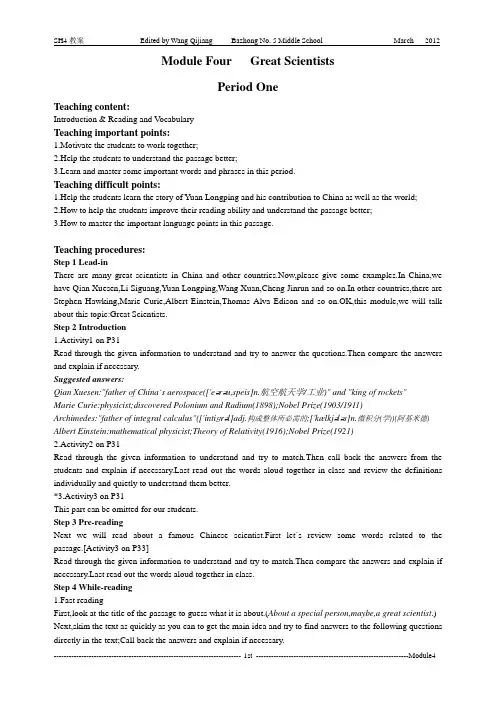
Module Four Great ScientistsPeriod OneTeaching content:Introduction & Reading and V ocabularyTeaching important points:1.Motivate the students to work together;2.Help the students to understand the passage better;3.Learn and master some important words and phrases in this period.Teaching difficult points:1.Help the students learn the story of Yuan Longping and his contribution to China as well as the world;2.How to help the students improve their reading ability and understand the passage better;3.How to master the important language points in this passage.Teaching procedures:Step 1 Lead-inThere are many great scientists in China and other countries.Now,please give some examples.In China,we have Qian Xuesen,Li Siguang,Yuan Longping,Wang Xuan,Cheng Jinrun and so on.In other countries,there are Stephen Hawking,Marie Curie,Albert Einstein,Thomas Alva Edison and so on.OK,this module,we will talk about this topic:Great Scientists.Step 2 Introduction1.Activity1 on P31Read through the given information to understand and try to answer the questions.Then compare the answers and explain if necessary.Suggested answers:Qian Xuesen:"father of China`s aerospace(['eərəu,speis]n.航空航天学/工业)" and "king of rockets"Marie Curie:physicist;discovered Polonium and Radium(1898);Nobel Prize(1903/1911) Archimedes:"father of integral calculus"(['intiɡrəl]adj.构成整体所必需的;['kælkjələs]n.微积分(学))(阿基米德) Albert Einstein:mathematical physicist;Theory of Relativity(1916);Nobel Prize(1921)2.Activity2 on P31Read through the given information to understand and try to match.Then call back the answers from the students and explain if st read out the words aloud together in class and review the definitions individually and quietly to understand them better.*3.Activity3 on P31This part can be omitted for our students.Step 3 Pre-readingNext we will read about a famous Chinese scientist.First let`s review some words related to the passage.[Activity3 on P33]Read through the given information to understand and try to match.Then compare the answers and explain if st read out the words aloud together in class.Step 4 While-reading1.Fast readingFirst,look at the title of the passage to guess what it is about.(About a special person,maybe,a great scientist.) Next,skim the text as quickly as you can to get the main idea and try to find answers to the following questions directly in the text;Call back the answers and explain if necessary.Questions:1)What kind of student was Yuan Longping when he was young?2)What way did he think to produce rice more quickly?3)What did he discover?4)How important was the discovery?Suggested answers:1)He was a student with lots of questions and he was interested in plants.2)By crossing different species of rice plant, then he could produce a new plant which could give a higher yield than either of the original plants.3)He discovered a naturally sterile male rice plant in 1970.4)Chinese rice production rose by 47.5% in the 1990’s.There were other advantages.50,000 square kilometers of rice fields were converted to growing vegetables and other cash crops. Yuan’s rice was exported to other countries.His rice’s yield is much greater than the yield of other types of rice grown in Pakistan.2.Careful reading[Activity 2 on P32]Read through the text carefully to get more details and then finish Activity 2 on P32;Call back the answers and explain if necessary.Now write a different title for the passage.Give your reasons.【The Father of China`s Hybrid Rice.Because the passage mainly tells us Yuan Longping`s life and his contribution to development of Chinese hybrid rice.】nguage points【Ref:Notes to the text】Go through the text with the students together to explain some language points.Step 5 Post-readingGo through the text again individually and quietly to understand it better and then finish Activity 4 on P33. 【Pay attention to Learning to learn.】Step 6 Summary and Homework1.Summary: Summarize what they have learned in this period.2.Homework: Reading on P87-88 in workbook.Appendix: Notes to the text1.As a result of Yuan Longping`s discoveries Chinese rice production rose by 47.5 percent in the 1990`s. ▲rise by 增加了rise to 增加到e.g:This term,the number of students in our school has risen by 300 to 2800.2.50 thousand square kilometers of rice fields were converted to growing vegetables and other cash crops.▲convert…to / into…把…转变成;转变,改变(to prep.)e.g: That factory converts iron to steel.那家工厂把铁转变成钢。
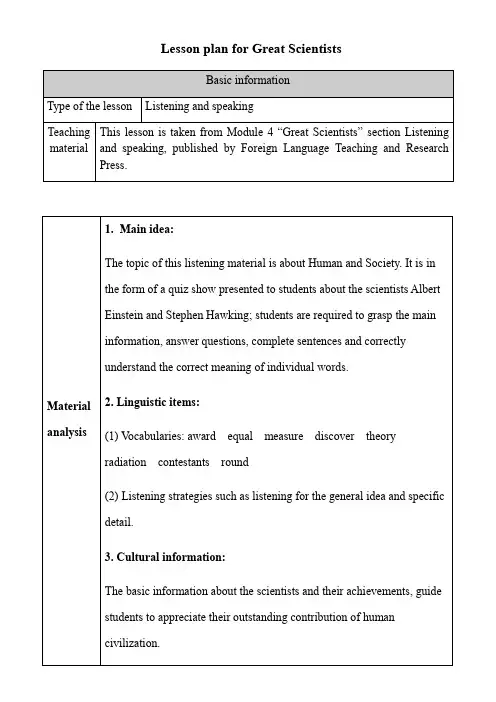
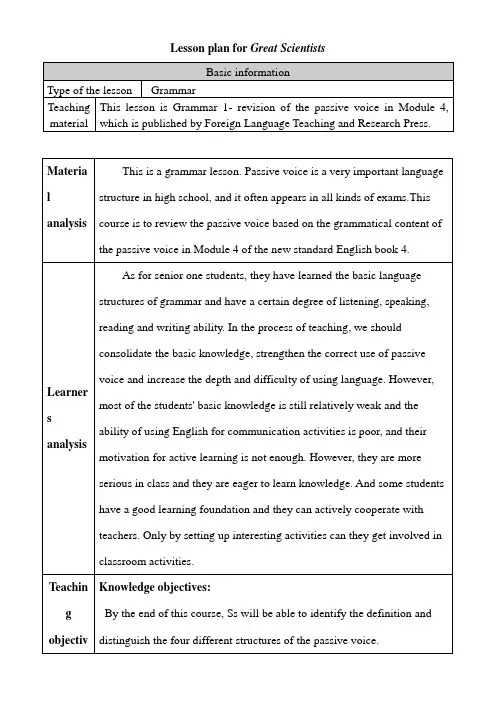
Lesson plan for Great ScientistsT e a c h i n g P r o c e d u r e sDesigning purpose Let Ss learn to observe the sentences’ structures and distinguish the different tenses.The teacher guides the students to make a simple summary of the passive voice they have learned and form a clear concept of it.Stage 3 Practice (10 mins) 1.Ask Ss to do the exercise 1 and exercise 2 of different tenses about the passive voice.Exercise 2Fill in the blanks.Part oneLihui: Let's learn other scientists.Lihua: Cailun is a great inventor I'd like to talk.Lihui: Great,we all know that Papermaking ___________(invent) by him.Lihua:Yes,with the development of society, different types of paper _______(develope) so far.Now, we will make some sentences in passive voice inpassive voice.You know,we should learn not only their forms but alsohow to use them correctly. Ask Ss to discuss the exercise in groupsand finish it.Practice 1: Make sentences according to the pictures and givenwords.2.Write a short dialogue within sive sentences to describe thescientists with the right types of PV. Scientists are asfollows:MadameCurie,Edison ect.3.Give some comments on the Ss’ performance and then give a briefconclusion.DesigningpurposeTrain their team spirit and guide them to combine the knowledgewith different contexts in order to use the passive voice correctly tomake sentences.According to Chomsky, a language learner acquire languagecompetence which enable him to produce language.So theB l a c k b o a r d/P P T D e s i g n(板书/媒体设计)。
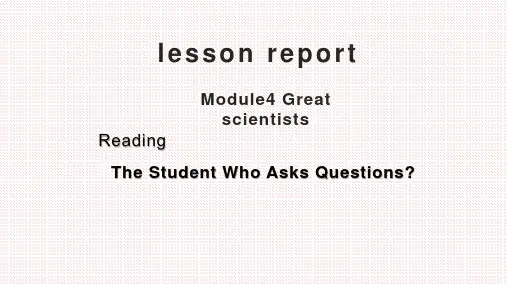
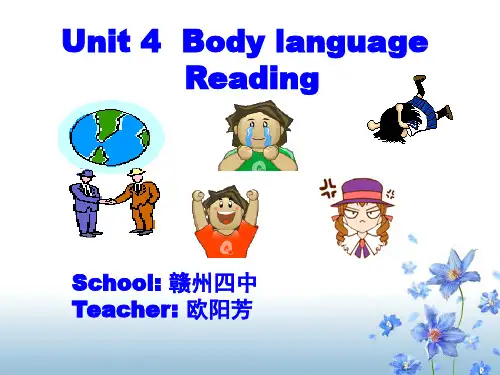
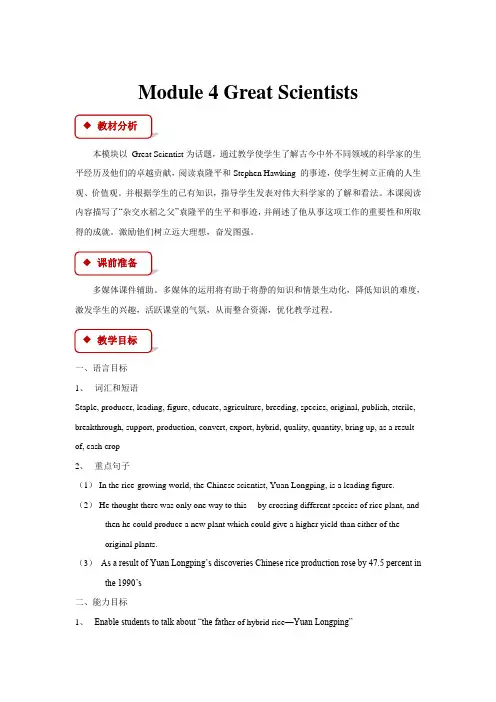
Module 4 Great Scientists本模块以 Great Scientist 为话题,通过教学使学生了解古今中外不同领域的科学家的生平经历及他们的卓越贡献,阅读袁隆平和Stephen Hawking 的事迹,使学生树立正确的人生观、价值观。
并根据学生的已有知识,指导学生发表对伟大科学家的了解和看法。
本课阅读内容描写了“杂交水稻之父”袁隆平的生平和事迹,并阐述了他从事这项工作的重要性和所取得的成就。
激励他们树立远大理想,奋发图强。
多媒体课件辅助。
多媒体的运用将有助于将静的知识和情景生动化,降低知识的难度,激发学生的兴趣,活跃课堂的气氛,从而整合资源,优化教学过程。
一、语言目标1、 词汇和短语Staple, producer, leading, figure, educate, agriculture, breeding, species, original, publish, sterile, breakthrough, support, production, convert, export, hybrid, quality, quantity, bring up, as a result of, cash crop2、 重点句子(1) In the rice-growing world, the Chinese scientist, Yuan Longping, is a leading figure.(2) He thought there was only one way to this ---by crossing different species of rice plant, andthen he could produce a new plant which could give a higher yield than either of theoriginal plants.(3) As a result of Yuan Longping’s discoveries Chinese rice production rose by 47.5 percent inthe 1990’s二、能力目标1、 Enable students to talk about “the fath er of hybrid rice —Yuan Longping”2、Understand the text answer the related questions.3、Enable the students to understand the details about the passage, choosing the correct answeraccording to the text and fill in the form about the passage.三、学能目标Help students learn how to talk about Yuan Longping and his achievements.1 Talk about “the father of hybrid rice---Yuan Longping”When and where was he born?Why was he famous?What did he discover?How important is the discovery?2 Discuss the question of comprehension:Why is Yuan Longping’s discovery very important?1 Understand the importance of scientists’ achievements.2 Discuss the questions:What would you think of the new hybrid rice if you are a rice farmer? Explain why.Is the title of the passage suitable? If not, write a new one and give the reasons.3 Discuss what the students can learn from Yuan Longping.Period 1 Introduction and cultural cornerStep 1 GreetingGreet the whole class as usual.Step 2 PresentationStep 3 Warming upShow the students some pictures of western great scientists and ask them to talk about who they are and what achievements they had.。
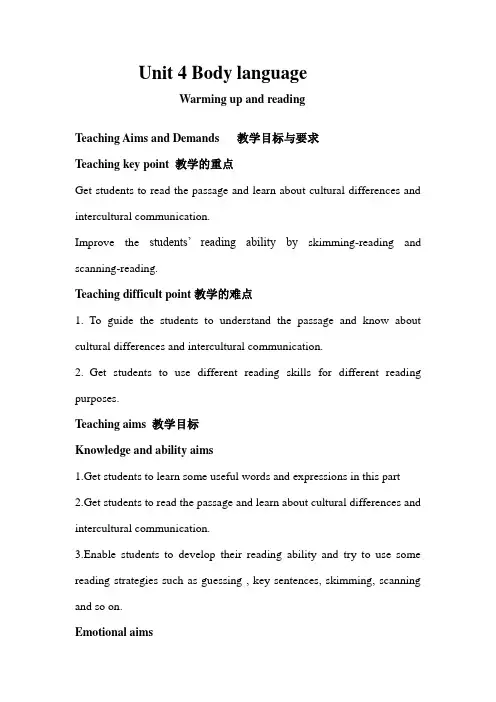
Unit 4 Body languageWarming up and readingTeaching Aims and Demands 教学目标与要求Teaching key point 教学的重点Get students to read the passage and learn about cultural differences and intercultural communication.Improve the students’ reading ability by skimming-reading and scanning-reading.Teaching difficult point教学的难点1. To guide the students to understand the passage and know about cultural differences and intercultural communication.2. Get students to use different reading skills for different reading purposes.Teaching aims 教学目标Knowledge and ability aims1.Get students to learn some useful words and expressions in this part2.Get students to read the passage and learn about cultural differences and intercultural communication.3.Enable students to develop their reading ability and try to use some reading strategies such as guessing , key sentences, skimming, scanning and so on.Emotional aims1.Enable students to recognize different body language and try to use them correctly.2.Develop students’ sense of cooperative.Teaching Methods1.Task-based teaching and learning2.Cooperative learning3.DiscussionTeaching AidsThe multimedia and other normal teaching toolsTeaching ProceduresStep 1 Leading in and warming up1.If a person can not speak, how you can communicate with him or her.2.can you do some gestures?3.Can you do some movements with your partners to communicate? Step 2 Pre-readingLook the title and pictures of this reading passage, predict the main idea of the text,Step 3 ReadingSkimmingRead the text quickly and answer two questions.1. what did the author do yesterday?2. Did any students have the same greeting customs?Then read this text quickly again , finish the following exercise.Suggest answers:China Columbia Britain Canada Japan Jordan France Scanning1.Give students 5min to read this text carefully again, and finish thefollowing exercise.( according to 1-2-3para)Suggest answers1). Stood watching greet moved back2). approached touched kissed cheek3). Stepped surprised put up defence4). Reached his hand out5). Bowed6). Moved close came closer nodded7). Shook hands and kissed2.Ask students to read Paragraphs 4-5 and finish the following true or false exercises1).Englishmen often stand close to others or touch strangers as soon as they meet2).Most people around the world now greet each other by kissing3).Japanese will bow to others as greeting4).People from Jordan will move very close to you as you introduce yourself to them5).Some body language in some countries are good while some countries’ body languages are bad.Suggested answers 1. F 2. F 3. T 4.T 5. FStep4课堂检测连线Part1( para1) A. It mainly talks about the examples cultural“body language”Part2.(para2-3) B. It tells us that different peoples havedifferent body language.Part3(para4) C. It is the summary of body language.Part4( Para5) D. The main idea is that you are sent toCapital International Airport to meetstudents.Step5 SummaryToday we have learned a text about body language, It plays an important role in daily communication, so it is very important to understand and use it correctly.Step6 Homework1. Finish off page 27 exercises2. Preview the next lesson( Important language points)。
Lesson plan for Great ScientistsT e a c h i n g P r o c e d u r e se.The new hybrid rice has been developed by the Yuan Longping High-tech AgricultureCompany of China.T:Now answer the following questions.1.Which sentence is in the present simple(passive voice)?2.Which sentences are in the past simple(passive voice)?3.Which sentence refers to the future?4.Which sentence is in the present perfect?3.Present the passive voice with four tenses on PPT the present simple, the pastsimple, the future simple, and the present perfect; then explain the usage of thesentences from the PPT one by one.4.Conclude the forms of the passive voice and show it on PPT.Designing purpose Let Ss learn to observe the sentences’structures and distinguish the different tenses.The teacher guides the students to make a simple summary of the passivevoice they have learned and form a clear concept of it.Stage 3Practice(10 mins)1.Ask Ss to do the exercise 1 and exercise 2 of different tenses about the passive voice.Exercise 2Fill in the blanks.Part oneLihui: Let's learn other scientists.Lihua: Cailun is a great inventor I'd like to talk.Lihui: Great,we all know that Papermaking ___________(invent) by him.Lihua:Yes,with the development of society, different types of paper _______(develope) sofar.Lihui:Maybe in the future, new paper _________(create) and _____ (use) in other area.Part 2Tom:Do you know some famous scientists?Tina:Yes,Stephen Hawking,he ________ (know) at home and abroad widely.Tom:for example?Tina:He _______(graduate) from Oxford University.In the 1960s,He________ (diagnose)with motor neurone disease.but he never gave up, his book A BriefHistory of Time________ (publish)in 1988.He is so outstanding and we _______( influence)by him.Tom:Right.we all believe his work_________ (use) in other new field that _______(explore)by others scientists recently.Designing purpose The exercises are designed at different levels which are from easy to difficult in various forms when considering the students’cognitive.This step is to givestudents chances to practise the language point—the passive voice, and guidestudents to consolidate and develop knowledge.Stage4 Production(11 mins )Discussion and making sentences in groups.1.Teacher show some pictures in the PPT, then ask Ss to discuss and describe the picture byusing the correct form of passive voice in groups. And some prompts are given besides thepicture.T: I think you have learned passive voice by hearts. Now, we will makesome sentences in passive voice in passive voice.You know,we should learn not onlytheir forms but also how to use them correctly. Ask Ss to discuss the exercise in groups andfinish it.Practice 1: Make sentences according to the pictures and given words.2.Write a short dialogue within sive sentences to describe the scientists with the right typesof PV. Scientists are as follows:MadameCurie,Edison ect.3.Give some comments on the Ss’ performance and then give a brief conclusion. Designing purpose Train their team spirit and guide them to combine the knowledge with different contexts in order to use the passive voice correctly to make sentences.According to Chomsky, a language learner acquire language competence which enable himto produce language.So the arrangement is to reinforce the knowledge they have learnedfrom this class.Stage 5Summary andhomework(5 mins)1.Summarize the knowledge we’ve learned today, make a comment on theirperformance during this class and point out what they need to improve.2. Assign the homework for Ss.a.Ask Ss to complete the exercises in the workbook on P85.e passive voice to write a passage at least 80 words by giving some hints.B l a c k b o a r d/P P T D e s i g n(板书/媒体设计)。
外研版高中英语Book4 Module4单元教学设计一:单元设计的原那么:1:提前一周单元整体备课,每周一次集体备课,主备人和其他成员共同优化单元教学设计。
2:根据各部分之间的紧密关系来划分单元课堂讲解。
3:各堂课重点突出,突出不同课型的特点。
〔精读;泛读;语法;听力和写作课〕4:重难点突出,详略得当,敢于取舍。
〔不要低估学生的自主学习能力,把一些他们可以处理的部分交给学生处理,比如本模块中Everyday English;Pronunciation;Function.教师可以稍做引导或大胆放给学生〕。
二:各板块间的分析和重新组合:第一节课:单元词汇+Introduction +Speaking+Cultural Corner1: 目标:本节课重点是词汇,口语和泛读。
2:组合原因:单元词汇是基础〔原材料〕+Introduction 〔单元导入,激发学习兴趣〕+Speaking〔是针对Introduction 的第三部分的口语练习,是对Introduction 的巩固和提升〕+Cultural Corner〔以阅读带动单词的复习并有针对性的展开泛读能力的培养〕3:巩固练习:课本86页词汇练习5-8. 泛读练习:87页练习9是关于两位科学家:Yuan Rongping and Monty Jones 的泛读,很好的知识。
4:词汇处理方法:单词提前一周分工每天记忆下一单元的某些词汇,保证在下单元新课前掌握单词的读和写;单词的检查:每位同学课前在单独的单词检查本上写出自己认为比较重要的20个单词的汉语,课堂开始组内交换测试和修改,组长负责把握组内听写情况,教师可以及时了解和采取补救措施。
第二节课:Vocabulary and reading1: 目标:词汇和精读。
〔词汇的使用和阅读技巧的培养〕2:阅读问题的设计要有目的性,重点突出,多样性〔选标题,划分段落;找主旨句,单项选择,判断正误…〕,循序渐进〔选择最正确标题---写出最正确标题;找出主旨句------试着写出主旨句…〕;注重学习方法的启发。
公开课教案】外研版高一英语必修四unit4 reading 教案___ will learn the new phrase "leading figure" and practice their ___.3.Cultural n:___ figure in Chinese history。
and his spirit of tism。
___。
and belief is something that can be ___.The lesson plan is based on Module 4 of the book "Great ___ Four" from the Foreign Language Teaching and Research Press。
The main topic of the lesson is "The Student Who Asked ns"。
which tells the story of Yuan Longping。
the father of hybrid rice。
The lesson discusses his school life and the ___ he made to the world.Students will learn the new phrase "leading figure" and practice their ___ the story of Yuan Longping。
It is important to note that Yuan Longping is a leading figure in Chinese history。
and his spirit of tism。
___。
and belief is something that can be___.___ students about the life and achievements of Yuan Longping。
Module4 Great Scientists ReadingPart One Teaching DesignPeriod 1 Reading—The Student Who Asked Questions■Goals●To learn to read passages with the passive voice andby+-ing about great scientists●To learn to read with strategies■ProceduresStep 1: Warming up by defining sciencesBiochemistry: A branch of chemistry studying the chemical behavior in living beings. Biochemistry is not only interested in the individual chemical components but also their vital interplay.Biology: the science that deals with living things. It is broadly divided into zoology, the study of animal life, and botany, the study of plant life. Subdivisions of each of these sciences include cytology (the study of cells), histology (the study of tissues), anatomy or morphology, physiology, and embryology (the study of the embryonic development of an individual animal or plant). Also included in biological studies are the sciences of genetics, evolution, paleontology, and taxonomy or systematic, the study of classification.Botany: the scientific study of plant life. As a branch of biology, it is also sometimes referred to as plant science(s) or plant biology. Botany covers a wide range of scientific disciplines that study the growth, reproduction, metabolism, development, diseases, and evolution of plants.Genetics: scientific study of the mechanism of heredity. While Gregor Mendel first presented his findings on the statistical laws governing the transmission of certain traits from generation to generation in 1856, it was not until the discovery and detailed study of the chromosome and the gene in the 20th cent that scientists found the physical basis of hereditary characteristics.Zoology: The original branches of zoology established in the late 19th century such as zoo-physics, bionomics have largely been subsumed into more broad areas of biology which include studies of mechanisms common to both plants and animals.Chemistry: the science of matter and its interactions with energy and itself (see physics, biology). Because of the diversity of matter, which is mostly in the form of atoms, chemists often study how atoms interact to form molecules and how molecules(分子) interact with each other.Physics: the science of Nature in the broadest sense. Physicists study the behavior and properties of matter in a wide variety of contexts, ranging from the sub-nuclear particles from which all ordinary matter is made (particle physics) to the behaviorof the material Universe as a whole (cosmology宇宙论).Step 2: Before you readPlease go over the word list for this module, paying attention to the pronunciation of the word, the relationship between its pronunciation and its spelling.Step 3: While you read1. Type of writing and summaries of The Student Who Asked Questions2. A diagram of The Student Who Asked Questions3. Complete the article with one word in each blankThe Chinese scientist, Yuan Longping, is a _1_ figure in the rice-growing world. When he was educated in school he was given the _2_ , “the student who asks questions”. From an early age he was so interested in plants that he _3_agriculture in college. As a young teacher he began experimenting in crop breeding. First Yuan Longping _4_ with different types of rice. The results became known in China in 1966.Then he _5_ his search for a special type of rice plant. It had to be male. It had to be sterile. Finally, in 1970 a _6_sterile male rice plant was discovered. This was the breakthrough. As a _7 _of Yuan Longping’s discoveries Chinese rice production rose by 47.5 percent in the 1990’s. There were other _8_, too. 50 thousand square kilometers of rice fields were converted to growing _9_and other cash crops. Following this, Yuan Longping’s rice was exported to other _10_, such as Pakistan1. What does “staple” mean in “In a hungry world rice is a staple food and China is the world’s largest producer”?A. chief or prominent among the products exported or produced by a country or district; chiefly or largely dealt in or consumed.B. basic, chief, or principal: staple industries.C. principally used: staple subjects of conversation.D. important and outstanding2. He studied agriculture in college and as a young teacher he began experiments in _____.A. crop breedingB. feeding peopleC. sterile male riceD. with different types of rice3. He thought that the key to have more rice was by _____.A. experimenting with different types of riceB. asking questionsC. crossing different species of rice plantD. searching for a special type of rice plant4. Finally, in 1970 a _____ was discovered. This was the breakthrough.A. staple foodB. new plant which could give a higher yieldStep 4: After you readYou are going to read the text again and draw a diagram of it. You may use the diagram to retell the story in your own words.。